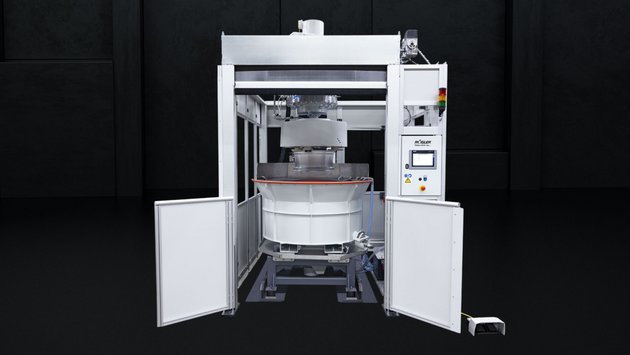
Mirror finish for high-end forged wheels in less than 40 minutes
Forged aluminum wheels are not only characterized by their low weight, high stability and excellent load bearing characteristics but also by their exclusive optical appearance. Therefore, it is not surprising that manufacturers of luxury cars are primarily utilizing forged aluminum wheels in their vehicles. Optical highlights of the high-end automotive wheels are not only their attractive design but also their immaculate high gloss polish. To achieve such a perfect finish the wheels must undergo a surface grinding and smoothing operation before they can be polished. Treating the wheels with classical vibratory finishing methods or finishing them with costly manual labor requires several hours of processing time. A leading wheel manufacturer wanted to significantly reduce the time requirements for partially finishing already painted bicolor wheels and was looking for a suitable technical solution. This was found with the Rösler plunge finisher R 1/1 TSA-O/VS-So. The plunge finishing technology was developed by Rösler for the consistent and quick deburring, edge radiusing, surface grinding and polishing of complex, heavy and delicate components.
Two stage process with specially adapted media and compounds

The finishing task for the bicolor wheels was particularly challenging – the already applied paint must not be damaged, and at the same time the surface areas to be finished must receive a brilliant, immaculate high gloss polish. The process runs as follows: With a pneumatic clamping system one single unfinished wheel is attached to the operating spindle of the plunge finisher. The specially designed clamping system allows manual as well as robotic mounting of the wheels. By lowering the rotating spindle the wheel is immersed into the processing bowl filled with special grinding or polishing media. For the cut-down/fine grinding operation cone shaped plastic media is utilized that was specially developed for this particular finishing application. The process is supported by the continuous addition of water and a suitable finishing compound. During the process, the spindle performs a centrical, orbital or a reciprocal rotation. The different rotational movements can also be combined. The resulting wheel motion ensures that consistent and homogeneous surface finishes are achieved, even on the most complex design details of the wheels. Repeatability and consistency of the achieved results was a key requirement for making the plunge finishing process suitable for volume production. This is achieved by special technical features like the vibratory motor attached to the processing bowl and a built-in undersized media classification system. Both ensure a stable media mix, which, in turn, guarantees a consistently good finishing quality.
The cut-down operation is followed by a fine grinding cycle of around seven minutes. For high gloss polishing the wheels are then placed into a second plunge finisher filled with porcelain polishing media. The polishing operation requires a processing time of 25 to 30 minutes.
Resource saving use of water and compound
For cleaning of the contaminated process water a chemical water treatment system, specifically designed to minimize the water and compound consumption, was installed. It is primarily used for cleaning the process water from the cut-down/fine grinding operation. The only slightly contaminated process water from the polishing process is collected in a buffer tank and re-used for the cut-down/fine grinding stage. The compounds required for each process stage are automatically injected. Re-using the process water from the polishing stage for the cut-down/fine grinding phase also helps in reducing the overall compound consumption.
The customer was not only impressed by the technical features but also the cost-efficiency of the plunge finishing technology. Therefore, it is not surprising that he already ordered additional plunge finishers for the next expansion phase of the wheel processing line.